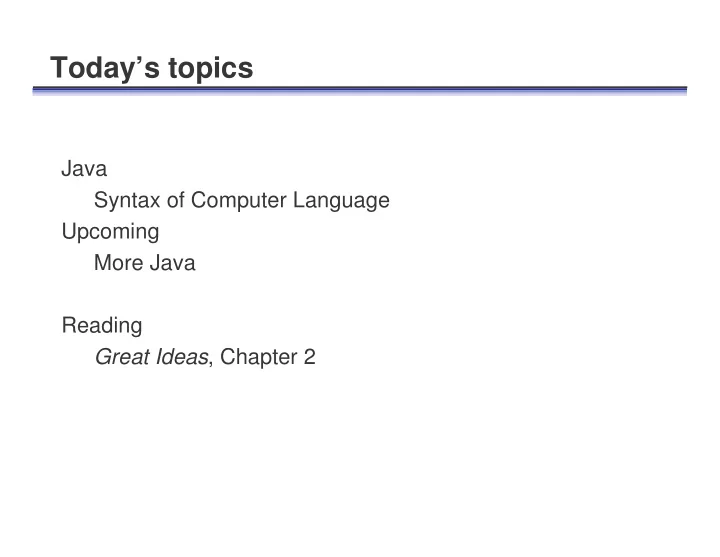

Today’s topics Java Syntax of Computer Language Upcoming More Java Reading Great Ideas , Chapter 2
Grammar • English and other natural languages have structure <S> => <NOUN-PHRASE> <VERB-PHRASE> <NOUN-PHRASE> => <NOUN> | <ARTICLE> <NOUN> <VERB-PHRASE> => <VERB> | <VERB> <NOUN-PHRASE> <NOUN> => DOG | FLEAS | PERSON | ... <VERB> => RAN | BIT | ... • Process of taking sentence and fitting it to grammar is called parsing DOG BIT PERSON <NOUN> <VERB> <NOUN> <NOUN-PHRASE> <VERB-PHRASE> <S> • Parsing English is complex because of context dependence
Formal specifications • Need a precise notation of syntax of a language • Grammars can also be used for generation • Grammar rule: <name> => sequence of letters and/or digits that begins with a letter • Grammar use: <name> => guessB <name> => msg42 • Substitute as many times as necessary . All legal statements can be generated this way • Want: person = firstn + " " + lastn; • How do we get this from our grammar?
A Grammar for Java • Need a set of rules • Our first one was a good start: • <name> => any string of alphanumeric symbols that begins with a letter • Let’s add something to define a simple statement: • <statement> => <name> = <expression> ; • And then work on the details: • <expression> => <string-expression> | <int- expression> | oth-expression> • <string-expression> => <string> • <string> => <name> • <string> => ” any sequence of characters ”
A Simple Statement Now have enough to generate a statement like: msg = “hello”; • Start with: <statement> => <name> = <expression> ; • Then using: <name> => any string of alphanumeric symbols that begins with a letter msg = <expression> ; • Then, using: <expression> => <string-expression> | <int-expression> | <oth-expression> msg = <string-expression> ; • Using: <string-expression> => <string> msg = <string> ; • Using: <string> => ” any sequence of characters ” msg = ”hello” ;
A Grammar for Java Including more rules to describe programs we have: 1. <name> => any string of alphanumeric symbols that begins with a letter 2. <statement> => <name> = <expression> ; 3. <statement> => <name> = new <class> ( <arguments> ); 4. <statement> => <name> . <method> ( <arguments> ); | 5. <arguments> => possibly empty list of <expression> s separated by commas 6. <expression> => <string-expresseion> | <int-expression> | <oth-expression> 7. <string-expression> => <string-expression> + <string-expression> 8. <string-expression> => <string> 9. <string> = ” any sequence of characters ” 10.<string> = <name>
Using our Grammar Use this to generate: person = firstn + " " + lastn; Rule Statement being Generated # 2: <statement> => <name> = <expression> ; 1: <statement> => person = <expression> ; 6: <statement> => person = <str-expression> ; 7: statement> => person = <str-expression> + <str-expression> ; 8: <statement> => person = <string> + <str-expression> ; 10: <statement> => person = <name> + <str-expression> ; 1: <statement> => person = firstn + <str-expression> ; 7: <statement> => person = firstn + <str-expression> + <str- expression> ; 8: <statement> => person = firstn + <string> + <str-expression> ; 9: <statement> => person = firstn + " " + <str expression> ; 8: <statement> => person = firstn + " " + <string> ; 10: <statement> => person = firstn + " " + <name> ; 1: <statement> => person = firstn + " " + lastn;
Proving Grammatical Correctness • Why go through the process we went through? • Shows that desired statement can be generated from this grammar • Actually proves that the statement is grammatically correct! • Same rigor as a mathematical proof • (Does not prove that logic is correct, though) • Actually need more rules to handle the level of Java we’ve covered so far • Summary of rules shown on pages 78-80 of Great Ideas • Also gives an example for a complete applet • Too long to go through in class – Please Read!
Recommend
More recommend